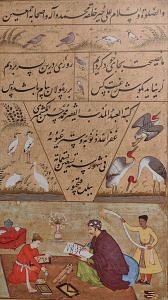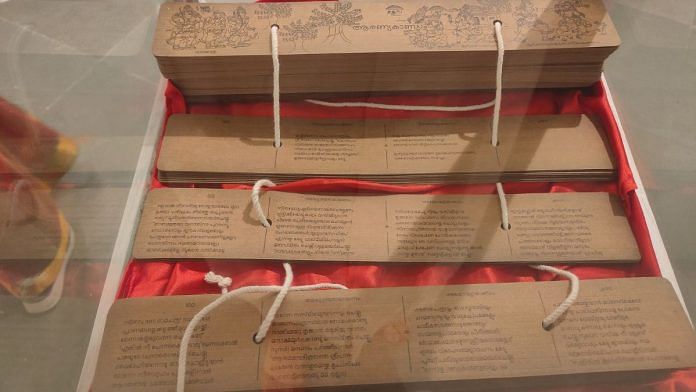New Delhi: In ancient times, monarchs would enlist scribes to immortalise their heroic deeds on palm leaves, leaving behind a legacy for the ages. These texts, written in Sanskrit, were eventually translated into other languages to make them widely accessible – a testament to the power of language and the written word.
About 30-40 printed versions of these now-digitised manuscripts can be seen at Delhi’s ‘Evam Vadati Pustakam’ exhibition until 28 September. The display is part of India International Centre’s SAMHiTA (South Asian Manuscript Histories and Textual Archives) project, which aims to create an accessible digital archive of ancient texts written on stones, iron plates, palm leaves and paper.
“There was a lot of give and take between scripts and languages. The same text sometimes had a mixture of two or three languages. So there was no clear division. Texts like Mahabharata and Ramayana, too, were translated into many languages,” said Sudha Gopalakrishnan, author and SAMHiTA project director. At the exhibition, a digitised version of the original 72-metre-long Mahabharata, put online by the University of Edinburgh, is displayed on an LED screen that viewers can touch and zoom into.
According to an exhibit handbook, this constant mix and match was evident in manuscripts from Bengal, which also contained some words in Tamil and Telugu, and the Siddhamatrika script, which eventually gave birth to languages like Ahom, Bengali, and Odia.
Gopalakrishnan cited the example of Razmanama, a Persian translation of the Mahabharata commissioned by Akbar in 1582. “It still has certain Sanskrit words in it.”

India’s manuscript history
India is known to be one of the largest manuscript sources in the world. The diverse nature of ancient scripts available in the country cover poems, history, arithmetic, and cosmology. According to an estimate by the National Mission for Manuscripts (NMM), an autonomous body under the Culture Ministry, India has over 10 million manuscripts in 80 ancient scripts like Brahmi, Lepcha, Kushan, and Gaudi.
It was through these written pieces that folklore, traditional beliefs and practices were transferred to generation after generation.
“Cultural rebuilding is very necessary. It would help one to understand the deep-rooted tradition and influence that our country has built over many centuries,” said Minister of External Affairs S. Jaishankar in his inaugural address at the exhibition.
“This initiative of making available the manuscripts in digitised formats will meet the greater objective of making the world ready for India, getting a fairer and greater understanding of our culture and heritage,” he added.
Launched in 2020, SAMHiTA project is backed by the MEA, which has allocated a fund of about Rs 1 crore for its successful completion, revealed Gopalakrishnan.
Also read:
Language in Indian manuscripts
The various manuscripts and storyboards on display at the exhibition captured the rich diversity of language in Indian texts. One of them recounted the story of a Bodhisattva from the Lalitavistara Sūtra, a Mahayana Buddhist text in Sanskrit. Here, the Bodhisattva in question astounded his school teacher by naming 64 scripts, starting with Brahmi and Kharosthi.
The manuscripts at the exhibit also explored the rules and pronunciations of Sanskrit as laid down by the scholar Panini. It was his Ashtadhyayi that encouraged more scribes and authors to write about languages and their rules.
An important chapter in the linguistic history of Indian manuscripts was the influence of Persian literature. As trade routes expanded, foreign languages began to impact Indian literature heavily. As a result, a lot of existing literature began to be translated into foreign languages. Furthermore, authors also adapted to a newer style of writing influenced by these languages and their literature.
Also read:
Evolution of manuscripts
Through printouts of SAMHiTA’s digital archives, the exhibition shows how Indian manuscripts travelled around the world and were translated into languages like Persian.
“As people travelled to different geographical locations and came in contact with newer people, newer ideas came to their minds,” said Gopalakrishnan.
The emergence of regional languages from different scripts came with a change in the mode of manuscript inscription, she added.
Gopalakrishnan also explained the impact of changing surfaces — from stones to iron plates to palm leaves and then paper — on manuscript writing.
“The letters used on palm leaves would be more rounded, whereas the letters used on stones and iron plates would have more straight lines and sharp cuts. All of this was done to prevent the surface from tearing,” she added.
The way text and illustrations were adapted was different for different places, said Gopalakrishnan. “The palm leaf illustrations found in Karnataka won’t be the same as those of Kerala or Rajasthan or Gujarat. It was dependent on perception and largely on the resources available,” she explained.
Coming to the question of women and their role in the manuscript writing culture, Gopalakrishnan said that only the more modern medical manuscripts dealing with cosmetology and health mentioned them. According to her, even though women wrote poems and literature at the time, they were not usually hired as scribes. Research is needed on this aspect of manuscripts, she said.
(Edited by Zoya Bhatti)



